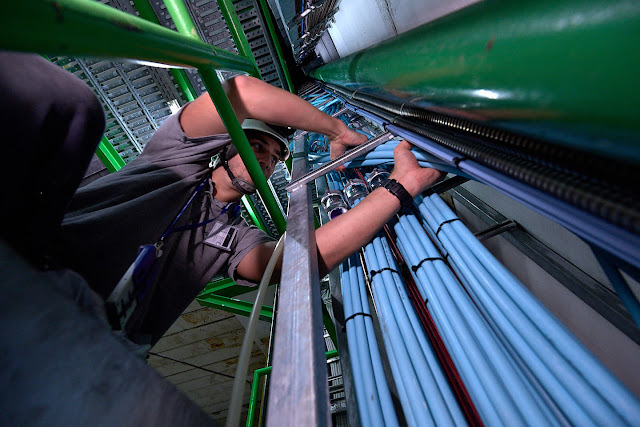mercredi 26 juin 2019
CERN - LS2 Report: 2000 kilometres of cable
CERN - European Organization for Nuclear Research logo.
26 June, 2019
Image above: During LS2, 20 000 optical fibres contained within 220 cables lie at the heart of the ALICE experiment (Image: CERN).
Some 40 000 cables will be installed or removed at CERN during LS2. Laid end to end, they would stretch for 2000 kilometres!
The work involves two types of cable: copper cables, which transmit signals to the accelerator systems and supply the magnets, and fibre-optic cables, which transmit data in the form of light signals. The latter weave through all of CERN’s installations, from Meyrin to Prévessin, including the accelerator tunnels, experiments and technical halls, like an enormous spider’s web.
“Optical fibres and copper cables transmit all the information collected or sent by the detectors, beam instrumentation, sensors, control panels, computing infrastructure, and so on,” explains Daniel Ricci, the leader of the section in charge of cabling (EN-EL-FC) within the EN department. “Our work covers all of CERN’s service networks: optical fibres and copper cables are everywhere.”
Image above: Water-cooled cables in the LHC tunnel. These cables carry the current (up to 13 000 amperes) from the power converters to the power supplies (Image: CERN).
They are indeed, and in impressive quantities: for example, some 20 000 optical fibres contained within 220 cables lie at the heart of the ALICE experiment, and 1200 copper signal cables are being installed in the SPS in the framework of the Fire Safety project. The EN-EL-FC section is also contributing to other major CERN projects during LS2, including the LIU (LHC Injectors Upgrade), the renovation of the East Area, the renovation of the SPS access system, the commissioning of the ELENA extraction lines and the HL-LHC.
“CERN is probably the only place in the world where several thousand kilometres of radiation-resistant optical fibre are needed,” says Daniel Ricci. “We maintain very close ties with industry, where our expertise is used to adapt and improve this type of fibre.”
Of the 40 000 cables to be dealt with during LS2, 15 000 are obsolete copper cables that need to be removed. But first, they need to be identified. Since CERN was founded 65 years ago, some 450 000 cables have been installed, and many of them are still snaking through the nooks and crannies of the Laboratory. “Since LS1, we have been methodically going through all of CERN’s old paper cable databases, identifying each cable and listing it in our digital database,” explains Daniel Ricci. “Of the 95 000 cables to be retained, 50 000 have already been digitised.”
Image above: Many cables that are still needed for operations were pulled out of their cable trays in order to facilitate the removal of obsolete ones (here, in the SPS) (Image: CERN).
CERN’s biggest ever cable removal campaign has been under way since 2016. During the most recent year-end technical stops (YETS and EYETS), the Booster and middle ring of the PS were relieved of their old, obsolete cables. Cable removal is currently under way at points 3 and 5 of the SPS.
To complete this gargantuan task, the EN-EL-FC section, which usually comprises 20 people, has recruited some outside help. Sixteen extra people – fellows, project associates and members of other groups – are lending a hand during LS2. The contractors’ teams, which comprise several dozen technicians working on site, have also been reinforced in order to keep up with the breakneck pace of work during the long shutdown. “Coordination, planning and teamwork are indispensable if we are to successfully complete the 120 cabling and cable removal projects scheduled for LS2,” says Daniel Ricci. “We’re lucky to have a very versatile team who are able to advise clients on different types of cable, carry out technical studies, organise logistics and coordination between the various parties and supervise the worksites.”
No fewer than 140 members of the CERN personnel and contractors’ personnel are working on the various LS2 cabling and cable removal projects, collaborating with the end users to ensure that quality control is as efficient as possible. “We would like to thank all the teams and users for their professionalism and their commitment. They are working to an extremely high standard while scrupulously respecting both deadlines and safety,” says Daniel Ricci.
Note:
CERN, the European Organization for Nuclear Research, is one of the world’s largest and most respected centres for scientific research. Its business is fundamental physics, finding out what the Universe is made of and how it works. At CERN, the world’s largest and most complex scientific instruments are used to study the basic constituents of matter — the fundamental particles. By studying what happens when these particles collide, physicists learn about the laws of Nature.
The instruments used at CERN are particle accelerators and detectors. Accelerators boost beams of particles to high energies before they are made to collide with each other or with stationary targets. Detectors observe and record the results of these collisions.
Founded in 1954, the CERN Laboratory sits astride the Franco–Swiss border near Geneva. It was one of Europe’s first joint ventures and now has 23 Member States.
Related links:
Long Shutdown 2 (LS2): https://home.cern/tags/long-shutdown-2
Fire Safety project: https://indico.cern.ch/event/752693/contributions/3118504/attachments/1706522/2749866/20180829_SPS_Safety_Project_Integration_Study_Fixed_Positions.pdf
LHC Injectors Upgrade (LIU): https://home.cern/fr/news/opinion/accelerators/time-lhc-injectors-upgrade-project
SPS access system: https://home.cern/fr/news/news/accelerators/ls2-report-sps-receives-major-facelift-new-beam-dump
ELENA: https://home.cern/news/news/accelerators/exceptionally-slow-antiprotons
HL-LHC.: https://home.cern/news/news/accelerators/halfway-high-luminosity
For more information about European Organization for Nuclear Research (CERN), Visit: https://home.cern/
Images (mentioned), Text, Credits: CERN/Anaïs Schaeffer.
Best regards, Orbiter.ch




